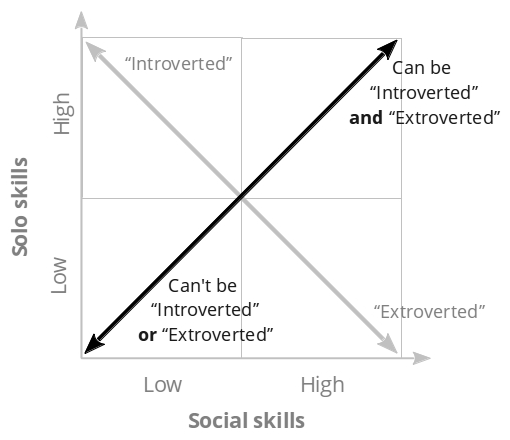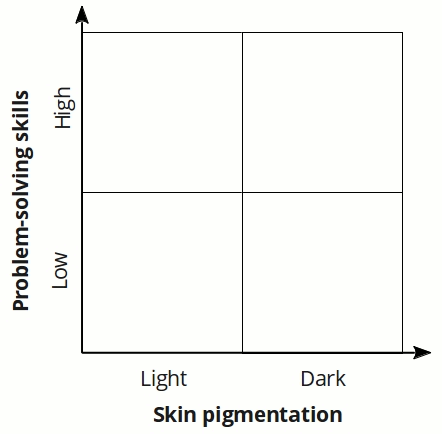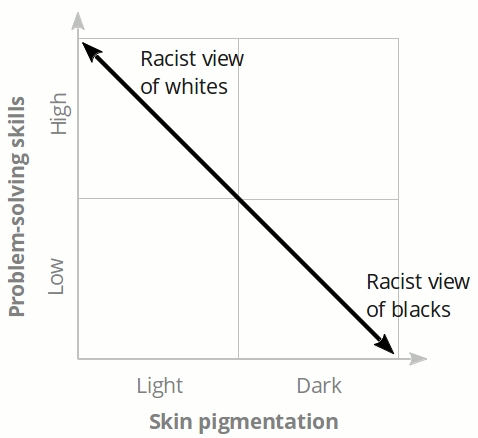Yesterday I wrote about freeing yourself from constraining beliefs. Today I’ll expand on creating new beliefs to free yourself from such constraints.
I wanted to illustrate at least one alternative to the standard one-dimensional model of introversion and extroversion that I find impedes self-awareness, understanding, and personal growth and development.

Many people continue to believe it because they have no alternative that helps their life more. Others rigidly hold on to their old belief because they can’t distinguish between the belief and the object of their belief — for example, telling people who disagree with their view that they don’t understand the definition of introvert or extrovert, not recognizing a definition describes a model not people. If you reject the model, those definitions don’t matter.
An alternative model
Here is an alternative model, slightly improved from my first post introducing it, “Introversion is not the opposite of extroversion, part 1.” Here I get rid of the concepts of introversion and extroversion as fundamental properties. I use the terms “Social skills” and “Solo skills” not to replace the concepts of introversion and extroversion, but as what they sound like. Social skills represents behaviors you can learn useful in social situations, like the abilities to introduce yourself to someone new, to carry on a mutually interesting conversation, to shake hands, and so on. Solo skills represents behavior you can learn useful on your own, like the abilities to focus on a solo task, to meditate, to avoid feeling bored, and so on.
As with any skills, you have to develop them. People start with few skills in either area. People can develop them in one area, the other, neither, or both.
 I find people high in social skills and poor in solo skills behave like so-called extroverts. People with high solo skills and poor in social skills behave like so-called introverts. If you believe in skills you can use this model without creating new concepts out of nowhere. I prefer simpler models that explain more to complex models that explain less.
I find people high in social skills and poor in solo skills behave like so-called extroverts. People with high solo skills and poor in social skills behave like so-called introverts. If you believe in skills you can use this model without creating new concepts out of nowhere. I prefer simpler models that explain more to complex models that explain less.
More importantly, this model suggests you can change how people perceive you and increase your capabilities by improving your skills. If you’ve learned to read and write, you’ve improved skills, so you know you can improve your skills. So if you felt you couldn’t change yourself under the one-dimensional model, the new model suggests you are free to change. (People who wonder why I harp on introversion and extroversion may see here the essence of my motivation. The one-dimensional model decreases your freedom to change, creating a mental jail. Like anyone, I viscerally oppose decreasing freedom and support creating freedom. Anyone can choose the skill level they want, but I feel it should be their choice, not one imposed on them by a confining belief.)
We can represent the one-dimensional model on the new one. It looks like this.
 It’s useful when a simpler model explains an old model and more. If you like the principle that among competing hypotheses, the hypothesis with the fewest assumptions should be selected — Occam’s Razor — you can get rid of the one-dimensional model.
It’s useful when a simpler model explains an old model and more. If you like the principle that among competing hypotheses, the hypothesis with the fewest assumptions should be selected — Occam’s Razor — you can get rid of the one-dimensional model.
The graph below shows a dimension missed by the one-dimensional model — that you can improve both sets of skills at once without giving up either. The old model calls people with equal skills “ambiverts,” but can’t distinguish between people who can’t function as either so-called introverts or so-called extroverts and people who can function equally well as both. This model distinguishes easily.
 The same analysis in another area
The same analysis in another area
I could have applied the same analysis to another area. Yesterday I mentioned slavery-supporting beliefs.
During slavery, people adopted the concept of race and saw blacks as one race and whites as another. These concepts were as made up as the introversion-extroversion one-dimensional model, introversion, extroversion, or the faces on Mars in yesterday’s pictures. Because people believed them, they saw patterns emerge. For example, many people then saw whites as skilled at solving problems and blacks as poor at solving problems. They associated high problem-solving skills with whiteness as two properties of one race and poor problem-solving skills with blackness as two properties of a different race.
Today most of us reject the concept of race but agree on concepts of problem-solving skills and skin pigmentation, seeing no innate correlation between the concepts. Instead of the racist’s one-dimensional model, we intuitively have a model as follows, though few of us would have thought to illustrate it graphically.
 It probably makes sense to most readers. People can have dark or light skin pigmentation and high or low problem-solving skills.
It probably makes sense to most readers. People can have dark or light skin pigmentation and high or low problem-solving skills.
Just like the two-sets-of-skills two-dimensional model can represent what people mean when they talk about introversion and extroversion thinking one-dimensionally, so can the skills-pigmentation model represent the slavery-supporting one-dimensional model. Again, using Occam’s Razor we could reject the one-dimensional model as unnecessary since it represents less while requiring new concepts that don’t help us understand the world.
 For completeness, let’s note that the new model lets us see things that believing the old model blinds us to. There are many types of people beyond what racists see, but their beliefs blind them from seeing them, like rock formations on Mars and people with ranges of social and solo skills.
For completeness, let’s note that the new model lets us see things that believing the old model blinds us to. There are many types of people beyond what racists see, but their beliefs blind them from seeing them, like rock formations on Mars and people with ranges of social and solo skills.
There are many consequences to these new models. For example, a slave-owner who adopted the new belief could see blacks with great problem-solving skills or whites who could develop theirs more. They could conclude that people could change their problem-solving skills, not be constrained by biology.
 Conclusion
Conclusion
The two-skills model explains more with less complication and assumptions than the one-dimensional model of introversion and extroversion. It also enables people to develop and grow more. Both are made up. Anyone is free to use either. The two-skills model improves my life in every way so I use it and I recommend it, rejecting nearly everything about the old model, especially its constraints on personal development and growth.

Pingback: Binary thinking that ruins your life » Joshua Spodek
Pingback: Read my blog, learn about yourself, get hired » Joshua Spodek
Pingback: My favorite posts | Joshua Spodek